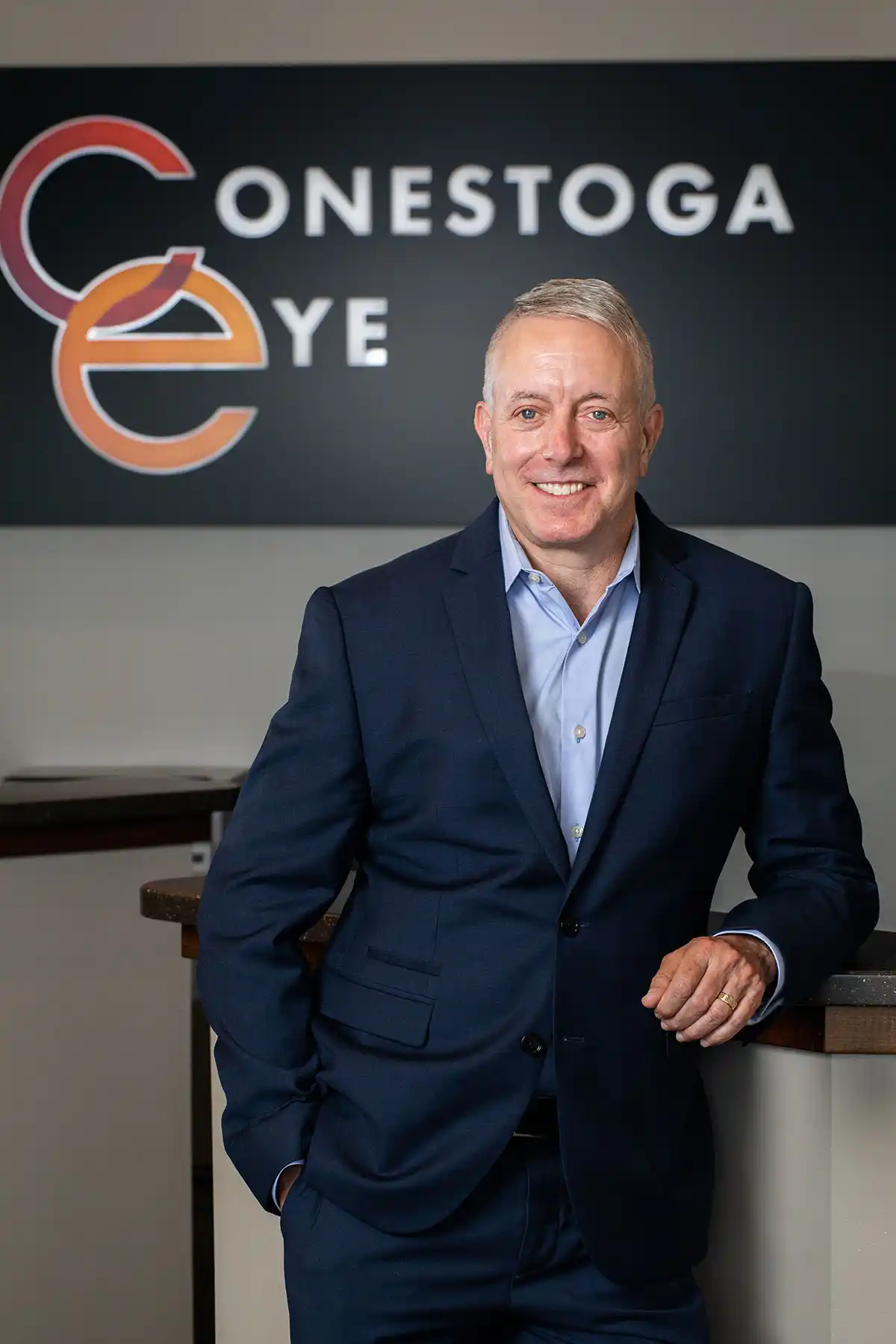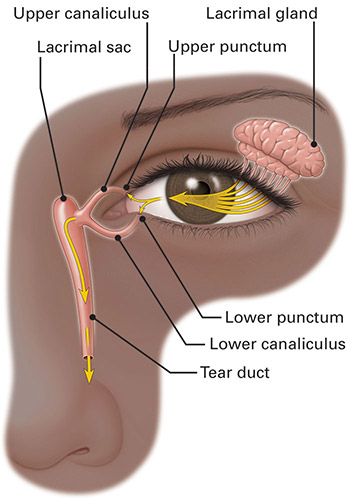Less Invasive Surgery for Tearing - No need for an incision in the face.
Excessive tearing called epiphora, is a condition where there is an overflow of tears onto the skin around the eyes. Epiphora can come from overproduction of tears due to dry eyes, allergies or blepharitis. When treatments with drops for allergy or dry eyes, punctal plugs, lid scrubs, IPL or other treatments don't help, it’s most likely the tearing is related to an obstruction of the tear drainage system and that’s when patients get sent to us at Conestoga Eye.
Complete or partial tear drainage obstruction is quite common. It increases in frequency with age and affects women twice as often as men. Epiphora can lead to symptoms such as blurry vision, eye irritation, skin maceration around the eyes, and recurrent eye infections. Complete tear drain obstruction can cause a more severe infection of the tear sac called dacryocystitis. Severe dacryocystitis can cause a facial infection called a cellulitis and if not corrected can lead to hospitalization for intravenous antibiotics.
Despite how common epiphora is, there is a lack of understanding about the minimally invasive procedures that we perform at Conestoga Eye which can address epiphora.

Office Visit with Probing and Irrigation
When you come in to see us for tearing or tear duct evaluation we will perform a focused eye examination evaluating the various causes for tearing. An office procedure will be performed at that visit assessing whether the tear drain is open. The tear drain will be topically numbed with proparacaine drops and lidocaine on a Q-tip. A very thin, smooth probe is carefully passed through the punctum, the small tear drainage opening in the eyelid, to make sure the passage is open. Then, a small amount of sterile saline is gently flushed through the duct to confirm that tears can flow normally into the nose. If the tear drainage system is open, you will taste the saline in your throat. In some cases this procedure itself can relieve the tearing especially if there is a stone in the system, but this will only help with minor blockages.
Tear Duct Stent Placement 
For patients with a partial nasolacrimal obstruction, Dr. Silbert will place a Kaneka Lacriflow Stent or a Nunchaku Stent. The stent is a self-retaining silicone stent that does not require it to be tied in the nose like older stents. It is made with an advanced polymer which allows it to be placed more easily in the office. The procedure is most often conducted under local anesthetic in the office but can be performed under sedation at an outpatient surgery center. Often the inferior punctum is snipped to open it slightly to allow better passage of tears. At times this procedure can be combined with ectropion repair, a procedure which tightens a loose lower lid to further improve tearing. The stents stay in place for 1 to 3 months, constantly recentering themselves, enlarging the tear drainage system in the process. After one to three months, the stent is removed easily in the office leaving a more patent tear drainage system that drains the tears better.
A small loop of tubing will stay visible in the corner of your eye between the upper and lower lids towards the nose. The tubes are generally left in for 1-3 months before they are removed. It is typical that you will continue tearing somewhat until the stents are removed.. The goal is to see improvement once the stents are out.
Kaneka Paper Saudi Journal of Medicine
Endoscopic DCR (Dacryocystorhinostomy) Surgery under General Anesthesia
In cases where there is a complete tear drain obstruction or in cases where stenting has been unsuccessful, a dacryocystorhinostomy (DCR) is recommended. Dr. Silbert exclusively performs Endoscopic DCR which requires no external incision allowing for a quicker recovery with minimal swelling and minimal bruising.
During a DCR, Dr. Silbert makes a new opening between the tear sac and the inside of the nose so that tears can flow freely again. The procedure is performed under general anesthesia and uses endoscopes allowing no external incision. Sometimes during surgery a small balloon is inflated in the channel to help expand the area. Stents will then be placed, either Kaneka, Nunchaku or Stent tubes, that stay in place for one to three months. Dr. Silbert has become an expert in Endoscopic DCR feeling that the procedure is far superior to external DCR.
Hear about the procedure directly from Dr. Silbert:

Why Endoscopic DCR?
The main advantage of Endoscopic DCR over Conventional DCR is that it is a minimally invasive procedure that does not require an external incision. Instead, it uses a small endoscope (a thin, flexible tube with a camera and light at the end) to access the blocked tear duct through the nose.
This results in less pain, less scarring, and a faster recovery time for the patient. In addition, the endoscopic approach allows for a better visualization of the nasal cavity and surrounding structures, which can result in better precision during surgery and lower risk of damage to nearby tissues.
Another disadvantage of Conventional DCR is that the skin incision may cause scarring and interfere with nosepads from eye glasses, making it difficult for the patient to wear glasses comfortably during the post-operative period. This is especially relevant for patients who rely on glasses for vision correction. In contrast, Endoscopic DCR does not involve any skin incisions and does not interfere with glasses placement.
Considering Surgery? Check our list of accepted insurances here.
Schedule an appointment with Dr. Silbert here.
Dr. Silbert has been published in Endoscopic DCR. Read about his revolutionary contributions to the field.
Dr. Silbert has made significant contributions to the advancement of lacrimal sciences. He led the PEDIG trials that assessed several aspects of the management of congenital nasolacrimal duct obstructions (CNLDO). Of nearly 100 publications by him, 13 are on the lacrimal drainage disorders.